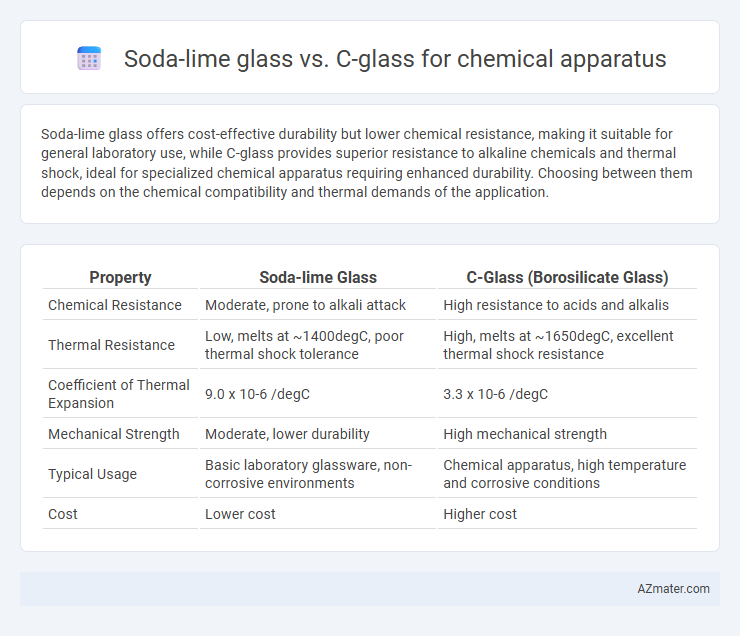Soda-lime glass offers cost-effective durability but lower chemical resistance, making it suitable for general laboratory use, while C-glass provides superior resistance to alkaline chemicals and thermal shock, ideal for specialized chemical apparatus requiring enhanced durability. Choosing between them depends on the chemical compatibility and thermal demands of the application.
Table of Comparison
| Property | Soda-lime Glass | C-Glass (Borosilicate Glass) |
|---|---|---|
| Chemical Resistance | Moderate, prone to alkali attack | High resistance to acids and alkalis |
| Thermal Resistance | Low, melts at ~1400degC, poor thermal shock tolerance | High, melts at ~1650degC, excellent thermal shock resistance |
| Coefficient of Thermal Expansion | 9.0 x 10-6 /degC | 3.3 x 10-6 /degC |
| Mechanical Strength | Moderate, lower durability | High mechanical strength |
| Typical Usage | Basic laboratory glassware, non-corrosive environments | Chemical apparatus, high temperature and corrosive conditions |
| Cost | Lower cost | Higher cost |
Introduction to Glass Types in Chemical Apparatus
Soda-lime glass, composed primarily of silica, sodium oxide, and calcium oxide, is widely used in chemical apparatus due to its affordability and good chemical resistance to neutral and mildly acidic substances. C-glass, or chemical borosilicate glass, contains boron oxide, enhancing its thermal and chemical durability, making it ideal for laboratory equipment exposed to sudden temperature changes and aggressive chemicals. Selection between soda-lime glass and C-glass depends on the specific chemical and thermal demands of the experimental application.
Composition of Soda-Lime Glass
Soda-lime glass primarily consists of about 70-75% silica (SiO2), 12-15% soda (Na2O), and 10-15% lime (CaO), which provides durability and chemical resistance for general laboratory glassware. In contrast, C-glass, or chemical glass, contains higher boron oxide (B2O3) content, enhancing thermal and chemical resistance beyond soda-lime glass capabilities. This compositional difference makes soda-lime glass less suitable for high-temperature or highly corrosive chemical applications compared to C-glass, especially in precision chemical apparatus.
Composition of C-Glass
C-glass, used in chemical apparatus, primarily consists of calcium oxide (CaO) and boron oxide (B2O3), which enhance its chemical durability and resistance to acids compared to soda-lime glass. Soda-lime glass is composed mainly of silica (SiO2), sodium oxide (Na2O), and calcium oxide (CaO), making it less resistant to thermal shock and chemical corrosion. The presence of boron oxide in C-glass provides superior performance in laboratory environments requiring robust corrosion resistance and thermal stability.
Chemical Resistance of Soda-Lime Glass
Soda-lime glass, commonly used in chemical apparatus, offers moderate chemical resistance but can be vulnerable to alkalis and hydrofluoric acid, limiting its application in highly corrosive environments. C-glass (chemical glass) exhibits superior resistance to acids, bases, and solvents, making it ideal for laboratory equipment exposed to aggressive chemicals. For applications requiring higher durability against chemical attack, C-glass is preferred over soda-lime glass due to its enhanced stability and longevity.
Chemical Resistance of C-Glass
C-Glass exhibits superior chemical resistance compared to soda-lime glass, making it ideal for handling aggressive chemicals and acids in laboratory and industrial chemical apparatus. Its high boron oxide content enhances durability against thermal shock and corrosion, ensuring longer lifespan under harsh chemical environments. Soda-lime glass, while cost-effective, lacks the enhanced chemical resilience necessary for prolonged exposure to strong reagents.
Thermal Properties Comparison
Soda-lime glass exhibits moderate thermal conductivity around 1 W/m*K and a coefficient of thermal expansion approximately 9 x 10-6 /degC, making it less resistant to thermal shock compared to C-glass. C-glass, a high-performance borosilicate glass, offers lower thermal expansion (about 3.3 x 10-6 /degC) and improved thermal shock resistance, crucial for precision chemical apparatus exposed to rapid temperature changes. The enhanced thermal stability of C-glass reduces the risk of cracking and deformation, ensuring better durability in lab environments.
Mechanical Strength: Soda-Lime vs C-Glass
Soda-lime glass exhibits moderate mechanical strength with a typical tensile strength around 40-60 MPa, making it suitable for general-purpose chemical apparatus but prone to breakage under thermal stress or impact. C-glass, specifically designed for chemical applications, offers superior mechanical strength with enhanced resistance to cracking and thermal shock, boasting tensile strengths up to 70-90 MPa. The improved durability of C-glass makes it ideal for high-stress environments, chemical reactors, and laboratory equipment requiring robust mechanical performance.
Cost and Availability Factors
Soda-lime glass is widely available and significantly more cost-effective than C-glass, making it a popular choice for chemical apparatus in budget-sensitive applications. Though C-glass offers enhanced chemical resistance and durability, its higher production costs and limited availability increase overall expenses. For general laboratory setups, soda-lime glass provides an economical solution without compromising basic functionality.
Applications in Laboratory Equipment
Soda-lime glass is widely used in laboratory equipment such as beakers, test tubes, and storage bottles due to its affordability and adequate chemical resistance for general-purpose applications. C-glass, or borosilicate glass, exhibits superior thermal and chemical resistance, making it the preferred choice for more demanding laboratory apparatus including volumetric flasks, condensers, and reaction vessels exposed to heat and corrosive chemicals. The enhanced durability and low thermal expansion of C-glass ensure greater safety and accuracy in precision laboratory work compared to soda-lime glass.
Choosing the Right Glass for Chemical Apparatus
Soda-lime glass exhibits excellent chemical resistance and cost-effectiveness, making it suitable for general-purpose chemical apparatus. C-glass offers superior alkaline resistance and high thermal stability, ideal for applications involving strong bases and temperature fluctuations. Selecting the right glass depends on the specific chemical environment, thermal demands, and budget constraints to ensure durability and safety in laboratory settings.

Infographic: Soda-lime glass vs C-glass for Chemical apparatus
 azmater.com
azmater.com